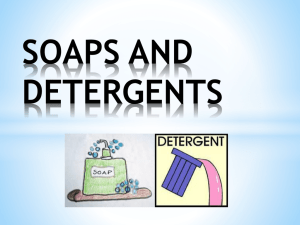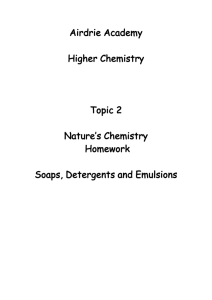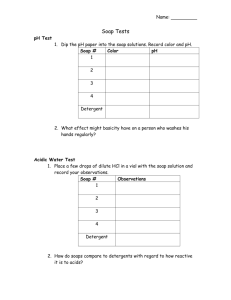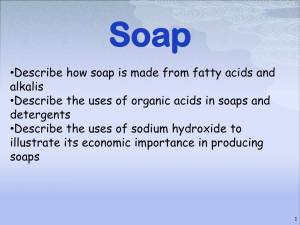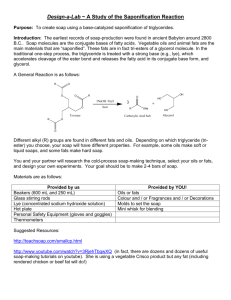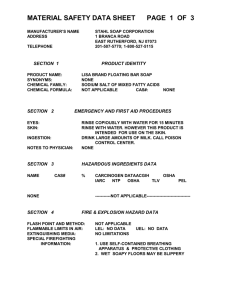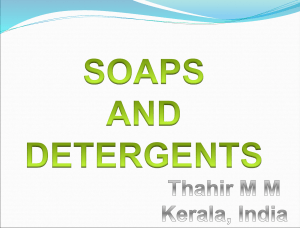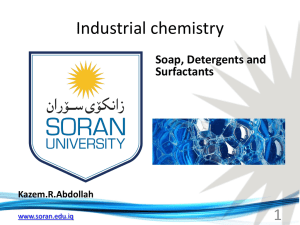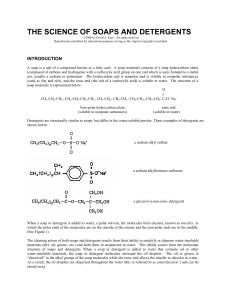Cleaning chemistry
advertisement
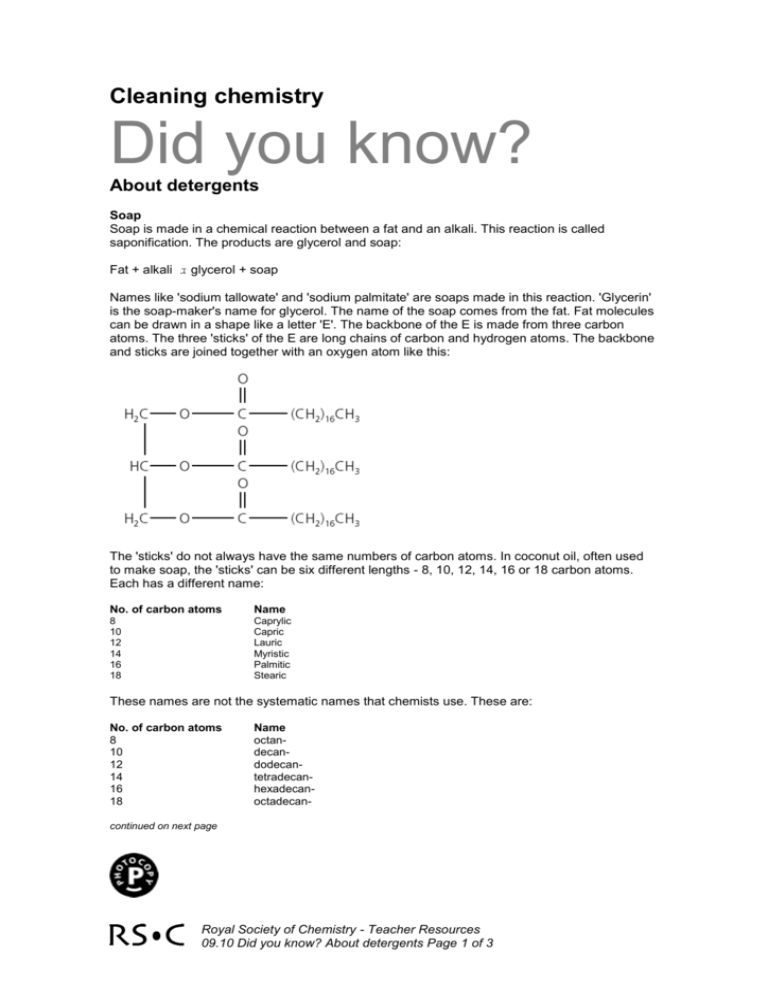
Cleaning chemistry Did you know? About detergents Soap Soap is made in a chemical reaction between a fat and an alkali. This reaction is called saponification. The products are glycerol and soap: Fat + alkali ɹ glycerol + soap Names like 'sodium tallowate' and 'sodium palmitate' are soaps made in this reaction. 'Glycerin' is the soap-maker's name for glycerol. The name of the soap comes from the fat. Fat molecules can be drawn in a shape like a letter 'E'. The backbone of the E is made from three carbon atoms. The three 'sticks' of the E are long chains of carbon and hydrogen atoms. The backbone and sticks are joined together with an oxygen atom like this: The 'sticks' do not always have the same numbers of carbon atoms. In coconut oil, often used to make soap, the 'sticks' can be six different lengths - 8, 10, 12, 14, 16 or 18 carbon atoms. Each has a different name: No. of carbon atoms Name 8 10 12 14 16 18 Caprylic Capric Lauric Myristic Palmitic Stearic These names are not the systematic names that chemists use. These are: No. of carbon atoms 8 10 12 14 16 18 Name octandecandodecantetradecanhexadecanoctadecan- continued on next page Royal Society of Chemistry - Teacher Resources 09.10 Did you know? About detergents Page 1 of 3 Cleaning chemistry continued from previous page The alkali The alkali is sodium hydroxide, formula NaOH. There are millions of sodium and hydroxide particles in one small granule of solid sodium hydroxide always in a 1:1 ratio. These particles are positively and negatively charged and are called ions. The sodium hydroxide structure is formed because the oppositely charged particles attract each other. The sodium and hydroxide particles separate when added to water, making a solution. Sodium hydroxide is also called 'lye', meaning 'lather' or 'bathe' in Latin. It is also called 'caustic soda'. The saponification reaction In the reaction, the fat molecule breaks up. The hydroxide particles make new bonds with the 'backbone', forming glycerol. The sodium particles make new bonds with the carbon/hydrogen chains, making soaps, like this: The reaction is started with some heat, used to break the first bonds in the fat molecules. Energy is released when the new bonds are made. The reaction is exothermic because the energy required to break the bonds is less that than the energy released when the new bonds form. Fat molecules are large and do not move very quickly, or mix easily with water, so it takes time for the reactants to meet. This is why stirring and time is needed to make soap. The reaction goes on after the soap is poured into moulds. Giving it time to stop is called 'curing'. This makes sure there is no sodium hydroxide left over which could damage skin. Soapless detergents When a soap is used in 'hard' water, a solid substance we call 'scum' forms. This is because present in the water react with soap to form an insoluble substance. Scum builds up on clothes, baths and sinks. Detergents do not form scum. They are made from propene (formula CH3-CH=CH2) a compound from distilling crude oil. A complicated series of reactions turns propene into a detergent. Like soap, detergent molecules have a long chain of carbon and hydrogen atoms, but at the end of the molecule there is this group: -SO3 - Na+ instead of the -COO - Na+ group present in soap. This difference stops scum forming. When scum forms, sodium is replaced with a calcium or magnesium particle. The new substance, scum, does not dissolve in water. When a calcium or magnesium particle reacts with a detergent molecule, the new substance does dissolve in water, so there is no scum. continued on next page Royal Society of Chemistry - Teacher Resources 09.10 Did you know? About detergents Page 2 of 3 Cleaning chemistry continued from previous page Problems with soapless detergents When a soap solution is washed away, the soap molecules break up into smaller molecules containing carbon, hydrogen and oxygen atoms. These go back into the soil and are taken up by plants and microorganisms. Detergents break down in a similar way, but take much longer. This is why foam is sometimes seen on rivers and streams – the detergent molecules keep their properties much longer than soap. Although detergents are good at removing grease and dirt, they can also irritate and dry out the skin. Some people are sensitive to detergents and may have skin reactions when using products which contain them. Questions 1. What soaps could be made from coconut oil? Write the word equation showing how one of these is formed. 2. Which soap bars include soaps from coconut oil? 3. Why is soap left to 'cure' before use? 4. Why does saponification take a long time? 5 How could the reaction to make soap be speeded up? Why might this help soap makers? 6. Why are detergents better to use for cleaning in hard water areas? Why are 'water softeners' added to some soap products? Royal Society of Chemistry - Teacher Resources 09.10 Did you know? About detergents Page 3 of 3
